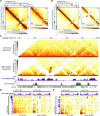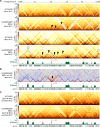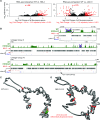A constitutive heterochromatic region shapes genome organization and impacts gene expression in Neurospora crassa
- PMID: 39701998
- PMCID: PMC11660810
- DOI: 10.1186/s12864-024-11110-7
A constitutive heterochromatic region shapes genome organization and impacts gene expression in Neurospora crassa
Abstract
Background: Organization of the eukaryotic genome is essential for proper function, including gene expression. In metazoans, chromatin loops and Topologically Associated Domains (TADs) organize genes into transcription factories, while chromosomes occupy nuclear territories in which silent heterochromatin is compartmentalized at the nuclear periphery and active euchromatin localizes to the nucleus center. A similar hierarchical organization occurs in the fungus Neurospora crassa where its seven chromosomes form a Rabl conformation typified by heterochromatic centromeres and telomeres independently clustering at the nuclear membrane, while interspersed heterochromatic loci aggregate across Megabases of linear genomic distance to loop chromatin in TAD-like structures. However, the role of individual heterochromatic loci in normal genome organization and function is unknown.
Results: We examined the genome organization of a Neurospora strain harboring a ~ 47.4 kilobase deletion within a temporarily silent, facultative heterochromatic region, as well as the genome organization of a strain deleted of a 110.6 kilobase permanently silent constitutive heterochromatic region. While the facultative heterochromatin deletion minimally effects local chromatin structure or telomere clustering, the constitutive heterochromatin deletion alters local chromatin structure, the predicted three-dimensional chromosome conformation, and the expression of some genes, which are qualitatively repositioned into the nucleus center, while increasing Hi-C variability.
Conclusions: Our work elucidates how an individual constitutive heterochromatic region impacts genome organization and function. Specifically, one silent region indirectly assists in the hierarchical folding of the entire Neurospora genome by aggregating into the "typical" heterochromatin bundle normally observed in wild type nuclei, which may promote normal gene expression by positioning euchromatin in the nucleus center.
Keywords: Neurospora crassa; Chromosome conformation; Gene expression; Genome organization; Heterochromatin.
© 2024. The Author(s).
Conflict of interest statement
Declarations. Ethics approval and consent to participate: Not applicable. Consent for publication: Not applicable. Competing interests: The authors declare no competing interests.
Figures







Update of
-
A Constitutive Heterochromatic Region Shapes Genome Organization and Impacts Gene Expression in Neurospora crassa.bioRxiv [Preprint]. 2024 Oct 14:2024.06.07.597955. doi: 10.1101/2024.06.07.597955. bioRxiv. 2024. Update in: BMC Genomics. 2024 Dec 20;25(1):1215. doi: 10.1186/s12864-024-11110-7. PMID: 39229016 Free PMC article. Updated. Preprint.
Similar articles
-
A Constitutive Heterochromatic Region Shapes Genome Organization and Impacts Gene Expression in Neurospora crassa.bioRxiv [Preprint]. 2024 Oct 14:2024.06.07.597955. doi: 10.1101/2024.06.07.597955. bioRxiv. 2024. Update in: BMC Genomics. 2024 Dec 20;25(1):1215. doi: 10.1186/s12864-024-11110-7. PMID: 39229016 Free PMC article. Updated. Preprint.
-
The genome organization of Neurospora crassa at high resolution uncovers principles of fungal chromosome topology.G3 (Bethesda). 2022 May 6;12(5):jkac053. doi: 10.1093/g3journal/jkac053. G3 (Bethesda). 2022. PMID: 35244156 Free PMC article.
-
Histone deacetylation and cytosine methylation compartmentalize heterochromatic regions in the genome organization of Neurospora crassa.Proc Natl Acad Sci U S A. 2023 Nov 21;120(47):e2311249120. doi: 10.1073/pnas.2311249120. Epub 2023 Nov 14. Proc Natl Acad Sci U S A. 2023. PMID: 37963248 Free PMC article.
-
The Black Book of Psychotropic Dosing and Monitoring.Psychopharmacol Bull. 2024 Jul 8;54(3):8-59. Psychopharmacol Bull. 2024. PMID: 38993656 Free PMC article. Review.
-
Microscopy methods for the in vivo study of nanoscale nuclear organization.Biochem Soc Trans. 2025 Feb 3;53(1):BST20240629. doi: 10.1042/BST20240629. Biochem Soc Trans. 2025. PMID: 39898979 Free PMC article. Review.
References
-
- Cremer T, Cremer C. Chromosome territories, nuclear architecture and gene regulation in mammalian cells. Nat Rev Genet. 2001;2:292–301. - PubMed
-
- Misteli T. Beyond the sequence: Cellular Organization of genome function. Cell. 2007;128:787–800. - PubMed
-
- Sexton T, Cavalli G. The role of chromosome domains in shaping the functional genome. Cell. 2015;160:1049–59. - PubMed
-
- Bonev B, Cavalli G. Organization and function of the 3D genome. Nat Rev Genet. 2016;17:661–78. - PubMed
MeSH terms
Substances
Grants and funding
LinkOut - more resources
Full Text Sources
Molecular Biology Databases

